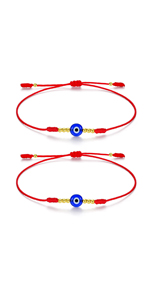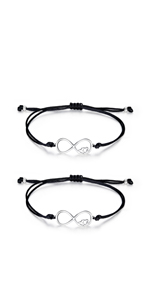The evil eye red bracelet, often adorned by individuals across various cultures, is not merely a fashion accessory; it is steeped in rich history and profound cultural significance. This small piece of jewelry serves as a protective talisman against negative energies and envious gazes. In this article, we will explore the origins, traditions, and meanings behind the evil eye red bracelet, uncovering its enduring allure in contemporary society.
Understanding the Evil Eye: Origins and Beliefs

The concept of the “evil eye” dates back thousands of years, with its roots tracing back to ancient civilizations such as Mesopotamia, Greece, and Rome. The term refers to a malevolent glare, often believed to cause harm or misfortune to the recipient. The belief in the evil eye transcends geographic boundaries and can be found in various cultures around the world.
- Mesopotamia: Ancient artifacts, including amulets and inscriptions, reveal that the evil eye was a significant concern in Mesopotamian cultures as early as 3000 BC.
- Greece: The Greeks referred to the evil eye as “mati” and believed it could be cast unintentionally by someone harboring jealousy.
- Middle East: In many Middle Eastern cultures, the evil eye is known as “nazar” and is often depicted as a blue eye symbol. This belief has persisted for centuries.
The Red Bracelet: Symbolism and Significance

The evil eye red bracelet is often made from red thread, beads, or stones, each element carrying its own significance. The color red is particularly noteworthy in many cultures, symbolizing protection, strength, and vitality. Here are some of the key meanings associated with the red bracelet:
- Protection: The primary purpose of the red bracelet is to ward off negative energy and protect the wearer from the evil eye.
- Strength: Red is considered a powerful color that can instill courage and resilience in the wearer.
- Connection: In many cultures, the red bracelet is a symbol of connection to one’s heritage and traditions.
Global Variations of the Evil Eye Red Bracelet
While the evil eye red bracelet is common in many cultures, its designs and meanings can vary significantly. Here are a few notable examples:
1. Turkish Nazar Boncuğu
In Turkey, the nazar boncuğu is a well-known symbol of the evil eye. This blue-and-white glass bead is often incorporated into jewelry, including red bracelets. It is believed to reflect the envy back to the person casting it, thereby protecting the wearer.
2. Hindu Tradition
In Hindu culture, the red thread, known as “kalava,” is often tied around the wrist during religious ceremonies. This thread serves as a protective amulet, warding off negative energies and bad luck.
3. Jewish Tradition

The red string bracelet, often worn by Kabbalists, is believed to protect against the evil eye. The string is typically tied around the left wrist, which is considered the receiving side of the body. This practice has its roots in biblical traditions and is often linked to the story of Rachel, who is said to have worn a red string to protect her children.
The Evolution of the Evil Eye Red Bracelet in Contemporary Culture
As globalization continues to blend cultural practices, the evil eye red bracelet has seen a resurgence in popularity in modern fashion and lifestyle. It is now commonly worn by celebrities and influencers, further embedding it into contemporary culture. Here are some reasons for its growing popularity:
- Fashion Statement: The evil eye red bracelet is often seen as a trendy accessory, appealing to those who appreciate its aesthetic qualities.
- Spiritual Awareness: Many individuals are increasingly drawn to spiritual practices and beliefs, leading to a renewed interest in protective symbols.
- Gift-Giving: The bracelet is often given as a gift, symbolizing love and protection for the recipient.
Case Studies: The Evil Eye Red Bracelet in Pop Culture

The influence of the evil eye red bracelet can be seen in various aspects of pop culture. Several celebrities have adopted this symbol, bringing it into mainstream fashion. Here are a few notable examples:
- Madonna: The pop icon has been known to wear red string bracelets, often associating them with protection and spirituality.
- Rihanna: The singer has been spotted wearing various forms of the evil eye jewelry, contributing to its visibility in the fashion industry.
- Gigi Hadid: The supermodel has also embraced the evil eye symbol, using it in her jewelry collections and public appearances.
The Impact of Social Media on the Evil Eye Red Bracelet

Social media platforms have played a crucial role in popularizing the evil eye red bracelet. Influencers and bloggers share their personal stories and beliefs surrounding the bracelet, often depicting it as a must-have accessory. This increased visibility has led to a surge in demand for these protective symbols.
Statistics show that searches for “evil eye jewelry” have increased significantly over the past few years, reflecting a growing interest in its cultural and spiritual significance. Platforms like Instagram and Pinterest are filled with images of the evil eye red bracelet, showcasing its versatility and appeal.
Conclusion: The Enduring Legacy of the Evil Eye Red Bracelet

The evil eye red bracelet is more than just an accessory; it is a symbol of protection, cultural heritage, and spiritual significance. Its rich history, rooted in ancient beliefs, continues to resonate through modern practices, making it a timeless emblem of resilience against negativity. From its origins in ancient civilizations to its contemporary resurgence in fashion, the evil eye red bracelet encapsulates a story of protection, connection, and cultural pride.
As we navigate a world filled with challenges and uncertainties, the evil eye red bracelet serves as a reminder of the protective forces we can invoke in our lives. Whether worn for its spiritual significance, as a fashion statement, or as a gift for loved ones, this small piece of jewelry holds a powerful legacy that transcends time and culture.